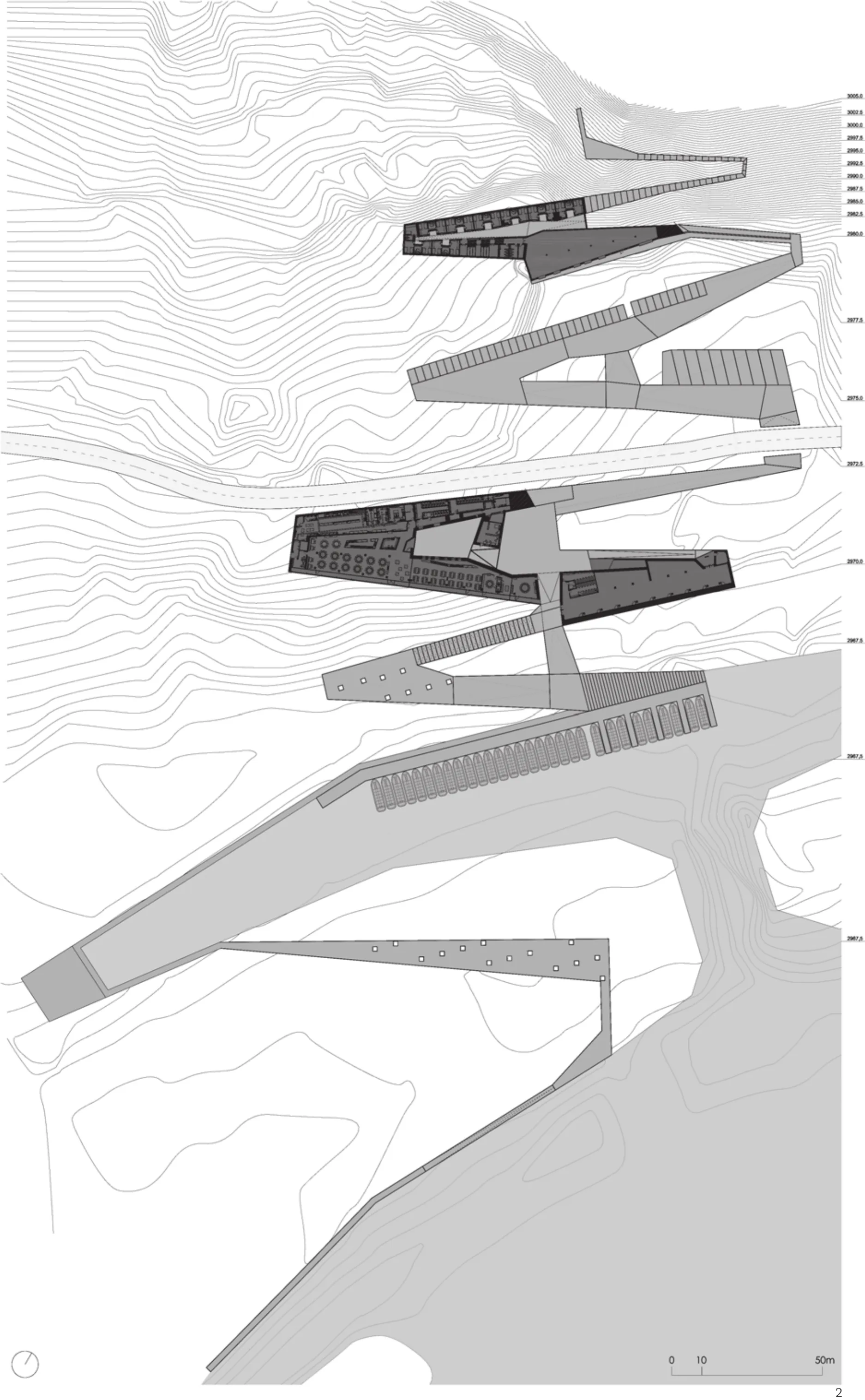娘欧码头,林芝,西藏,中国
建筑设计:标准营造+Embaixada
Architect: ZAO/standardarchitecture+Embaixada
娘欧码头是继2008年完工的派镇码头之后,标准营造与西藏旅游股份公司合作完成的一个较大的码头项目。这次标准营造邀请了好友葡萄牙年轻建筑师组合Embaixada参加项目的前期设计。码头坐落在林芝县境内,尼洋河和雅鲁藏布江交汇口的娘欧村附近,雅鲁藏布江在此处形成了一个缓冲的自然港湾,岸边的沙洲上生长着树龄上百年的柳树林。再往上地势由舒缓逐渐转为陡峭,背后是绵延不断的无名雪山。
项目的概念源于对西藏人文建筑和自然景观的解读:在西藏,建筑与景观密不可分,建筑即是景观,景观即是建筑。娘欧码头的设计中,我们希望将建筑嵌于景观之中,它既不是景观的附属也不是脱离于景观之上,因此便有了这条迂回曲折的坡道,这条坡道把码头相对复杂的各种功能整合在一起。从公路往上,坡道组织了巴士停车场、船员宿舍、后勤办公、会议室和员工电影院等功能,直至海拔3000m,坡道成为一个观景平台,引导游客回望远处雅鲁藏布江与尼洋河汇合处的壮观景象。坡道从公路往下延伸,沉降至海拔2971m的河岸,自然形成了驳船的码头,坡道下同样组织了售票厅、候船厅、餐厅、厨房、卫生间和发电站等多种服务与基础设施功能。这条坡道也因此定义了不同空间之间的复杂关系,生成了一个又一个平台和内部场所。建筑的每一块空间坚实地嵌入了周围的地势,协调着自然与人体间的微妙关系。
娘欧码头辗转迂回的体量不仅是对山势的诠释,也唤起了旅程的精神性。如同印度的下沉井在人步步下降的过程中辗转轮回,削弱了人与目的地的迫切联系,娘欧码头也试图延缓旅程。在向河岸的间接靠近中, 使人在脑海中积累了靠近水面的幻想,在最后一刻得到释放与满足。
坡道辗转处形成一个个开阔平台。平台不仅仅是流线间的过渡,在运动之后的静止中的短暂思考,同时也为瞭望山野建立了一系列独特的视框。平台的边界清晰地定义了视野,突兀的山崖和荒乱的草木也为这个鲜明的视框增添了几分人文色彩。通过设置开阔平台,使人们在此驻足,平台引导着人的视线,唤起了山谷与河流自身的神性,使人心生敬畏。我们在探讨一个关于现象的问题:一片景观的本身也许原始冗余而自我重复,然而人们从某个特定角度对它的思考与凝视却能赋予它精神性。建筑所能做的,只是提供一个思考的角度,一个凝视的方向。
建筑在个别转折处,围拢成一个户外庭院。站在庭院里的人看到天空的切割,感受到对院外景色的神秘感与未知感。除此之外,这些的户外空间更是原始环境和人文环境之间的相互牵制、相互流通,让人曝露回归于山野自然间的同时给予人文的庇护。
像标准营造的其它西藏项目一样,娘欧码头的地域特征不是通过具象的装饰或形式来表达,而是通过本地特有的建筑与土地山川的一体关系,以及本地材料的创造性再运用得到演绎。娘欧码头的主体为混凝土框架结构加石头墙砌体完成,墙体的石头是从基地附近采集,由当地的石匠通过自己的砌造方式构成的,观景平台的栏杆以当地拾来的木柴充当,经过风吹日晒,一种西藏特有的质朴的精神性和隐秘的当代性悄然呈现。□
Located in Linzhi County, Tibet, where Niyang River and the Yalung Zangbo River merge, the Niang'ou Terminal sits above a gently sloping bay,with old willows bowing over sand deltas. The bay then gradually turns into a steeper hill. Tiers of soft,nameless mountains stand behind.
The project originates from a reading of the primal landscape: in Tibet, architecture cannot be separated from landscape. The two are equivalent. In our design we immerse the building into the landscape, neither as an attachment or a detachment. Hence we arrive at this zigzagging path, which linearly integrates all complex functions. Arising from the highway, the ramp organises parking, staff dormitories, offces, conference rooms and theater, forming a wide platform at 3000m by altitude,guiding one's eyes back at the magnificent union of rivers. From the highway down to an altitude of 2971m,one finds a ticket office, bathrooms, waiting room,canteen and kitchen leading to a dock near the water.The ramp defines the relationship between various spaces, creating a chain of platforms and places. Each and every space firmly lodges into the landscape, subtly mediating the human body with nature.
The twist and turns not only emphasises the mountain ridges, but also calls for the spirituality of the journey. In the same way that the turn-anddescend of an Indian step well complicates one's expectation of his destination, Niang'ou Terminal also stretches the course. When approaching to the river bank, one cannot help but imagining and envisioning until a release at the final moment.
Every twist forms a platform, serving not only as the transition between circulations, but also a pause for contemplation and a frame for outside views. The boundaries of platforms clearly defines a view frame, in which the barren hills and disheveled bushes take on a hint of humanity. We have discussing a problem of phenomenology here:a primal and redundant landscape becomes sacred,when gazed and pondered upon by human eyes. The building provides an angle for pondering, as well as a direction for gazing.
Like other projects in Tibet by ZAO/standardarchitecture, the regional character is not manifested through specific symbolisms, but through a unique relationship with mountains and rivers as well as the creative interpretation of local lumber. The main body of the terminal consists of a concrete frame,filled in by local masonry, stones gathered from near the site and patterned by local builders in their own technique. The railing is built from fire wood collected nearby, narrating, after exposure to weathers, a quiet and humble contemporaneity.□

1 远景/Distant view

2 首层平面/Ground floor plan
3 屋顶/Roof


4 立面/Elevation
5 顶层平面/Roof plan
6 外景/Exterior view
7 屋顶/Roof
8 外景/Exterior view





9.10 外景/Exterior views
评论
青锋:禁欲者的救赎
虽然有着藏式传统民居的厚重性,娘欧码头看起来却更为原始。几乎没有什么线索能够提示这个建筑的建造时代。它更像是某种原始宗教建筑的遗址,只是被今天的人们借用来作为旅游服务设施。这种联想显然受到了建筑形体的启发。在石板铺砌的屋顶上折返前行,会让人想起藏人虔诚的转山。没有佛像或者殿宇,行程本身成为信仰的明证。
为了营造这种氛围,建筑做出了不少常规意义上的牺牲。可以使用的内部空间仅仅占据整个项目的一小部分,一些房间的光线与景观也让位于建筑整体的紧凑连贯。建筑师自己的克制也是显而易见的,除了石砌墙体、门窗洞口、以及局部的木材堆叠的栏板之外,设计者放弃了其他能够呈现自己精湛技巧的机会。无论是在对待建筑师还是对待使用者上,标准营造的这个项目都展现出一种近乎于“禁欲”或者“苦行”的意味。
这种“禁欲”式的克制是标准营造近期作品的普遍特点。建筑师的语汇日益收敛,多余的东西都被屏蔽在外,设计最终归结于一两个要素。但也就是这一两个要素,所产生的触动却让人难以忘怀。不同于极少主义的做作,标准营造的这些作品追求的并不是空寂,而是在滤除了干扰的情况下,让某些要素更为凸显出来。这种要素,在近期作品中更多呈现为一种特殊的视景。就像标准营造所撰写的作品说明中所提到的,娘欧码头并不提供一个崇拜对象,它启示的是超越日常的审视。
这样的“禁欲”更接近于亚瑟·叔本华所阐述的“美学意识”,它需要我们摆脱“日常意识”对个体、对个人意志、对利益得失的过度关注,在非功利性的审视中超越个体性的悲剧。我们实际上可以把藏人的转山视为类似的解脱过程。娘欧码头的“宗教性”或者说是“哲学意味”并不仅仅限定在藏族传统中,在更广泛的意义上,它可以启示每一个人,无论他是否是佛教徒。
因为与日常生活的距离,阿道夫·路斯认为只有缺乏功能的艺术品才能具有这种“禁欲”的特征。在他看来只有这样的艺术品才能称为建筑,其他的都只是房屋。这种割裂显然过于绝对了,生活与启示并不一定要相互对立,在娘欧码头的石台之上,或许可以感受到两者之间内在的联系。
Comment
QING Feng: The Redemption of Ascetics
Although bearing the heaviness of Tibetan traditional residence, the Niang'ou Boat Terminal looks even more primitive. There is hardly any clue indicating the construction time of the building. It's more like relics of some primitive religious architecture, only borrowed by people today as a tourist service establishment. This association is obviously inspired by the architectural formation. Walking back and forth on the stone paved roof reminds people of the Tibetan's pious mountain circling. Without any sacred statues or temples, the journey itself becomes a clear proof of faith.
In order to create such an atmosphere, the architecture had to sacrifice a lot in the conventional sense. Not only does the accessible interior space occupy merely a small part of the whole project,but the light and sight of some rooms also give way to the compactness and coherence of the whole building. The architect's own restraint is also evident. Apart from the stone masonry walls,the openings of doors and windows, and the stacked timber fences here and there, the designer abandoned any other opportunities to present his virtuosity. Whether for the architect or the users,this project of ZAO shows a sense that almost reaches the level of "abstinence" or "asceticism".
This "ascetic" restraint is the common characteristics of ZAO's recent works. The architect's vocabulary is increasingly constricted, redundant things are warded off, and design ultimately concentrates into only one or two elements. But precisely these one or two elements could cause an unforgettable stir. Different from the affectation of minimalism, what ZAO pursues is not emptiness, but letting certain elements stand out in the absence of any interference. Frequently,the distinctive elements chosen by ZAO falls into the category of special sights. As it is mentioned in the design description, Niang'ou Boat Terminal does not offer an object of worship, but inspires transcendent reflections.
Such "asceticism" is closer to the "aesthetic consciousness" described by Arthur Schopenhauer. It requires us to get rid of the excessive attention on the individual, the will, and the gain and loss in "ordinary consciousness", thus to overcome the individual tragedy by way of non-utilitarian contemplation.In fact, we can regard Tibetans' mountain circling as a similar process of liberation. The "religious" or"philosophical" meaning of Niang'ou Boat Terminal is not limited to the Tibetan tradition. In a broader sense,it can inspire everyone, whether Buddhist or not.
Because of the distance from everyday life, Adolf Loos believes that only works of art lacking function can possess this kind of "ascetic" characteristic. In his opinion,only such works of art could be called architecture,and others are just buildings. This split is obviously too absolute. Life and revelation do not necessarily oppose each other. On the stone platform of Niang'ou Boat Terminal, one may feel the internal connection between them. (Translated by CHEN Yuxiao)

